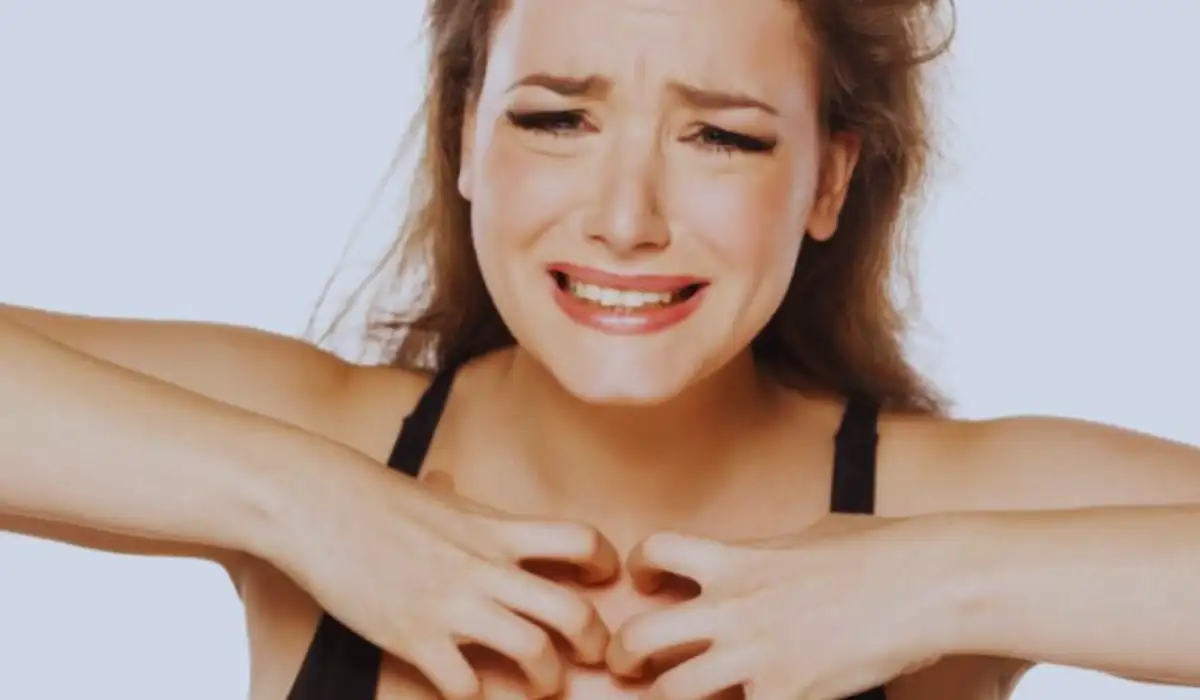Dealing with a rash under the breast can be irritating and alarming, as anyone who has experienced it would attest. Rashes as such aren’t just uncomfortable, but they may also raise a concern about one or other underlying health concerns.
The skin beneath the breast is delicate and thus susceptible to rashes. Especially, in conditions where warmth, moisture, and friction, the chances increase.
While in some cases, it could be due to the wrong choice of clothing and excessive sweating, in others, it might signal an allergic reaction or fungal infection.
Join us to understand this condition, its common and underlying causes and symptoms, diagnosis, and treatment.
What Is Rash Under Breast? A Brief Overview

A rash under the breast is a skin irritation/ inflammation that occurs in an area hidden under the breast. The rash is often characterized by redness, itching, and discomfort right where the skin folds.
Usually, the warm and moist environment under the breast creates an ideal setting for rash development. In some cases, it may resolve with proper hygiene and care, in other cases, it might require medical attention and treatment.
15 Causes of Rash Under Breast
Rash under the breast can be caused by a range of factors, including the following:
- Friction: Tight or ill-fitted bras and clothing lead to constant rubbing and thus can cause rashes under the breast.
- Moisture and Sweat: Accumulation of sweat and moisture in the skin folds under the breast causes humidity, thus fostering bacteria and fungi.
- Fungal Infection: Yeast infections, particularly candidiasis often thrive in warm, moist areas thus leading to rashes under the breast.
- Bacterial Infections: Cellulitis, a bacterial infection is known to cause inflammation and discomfort under the breast.
- Allergic Reactions: Constant contact with allergens present in the fabric due to skin care products, body products or laundry detergent can trigger allergic reactions thus causing a rash.
- Heat and Humidity: Constant exposure to high temperatures, especially in humid climates can lead to skin irritation and rash formation.
- Poor Ventilation: Lack of airflow under the breast can accumulate moisture increasing the chances of rash development.
- Intertrigo: This superficial inflammatory skin condition causes a red, moist, and itchy rash under the breast. It often comes along as a secondary infection.
- Pytiriasis Rosea: This common skin rash begins as an oval spot and may cause a small or larger patch under the breast.
- Hidradenitis suppurativa: This inflammatory skin condition causes deep bumps at different parts of the body although often under the breast. The condition is incurable however is manageable with treatment.
- Pemphigus: This rare autoimmune disorder may result in painful blisters and sores. The treatment for the same includes immunosuppressive drugs and corticosteroids.
- Hailey-Hailey Disease: It is a rare gene-linked disorder caused by repeating blister rashes in skin fold areas.
- Eczema: It is a long-term skin condition marked by redness, itchiness, and dry patches under the breast.
- Inverse Psoriasis: This condition causes inflammation in the skin folds, including under the breast region.
- Inflammatory Breast Cancer: Although rare, breast rashes may be a sign of breast cancer.
Symptoms of Rash Under Breast
The symptoms of rashes under the breasts manifest in the following ways:
- The affected skin may appear red and inflamed due to irritation.
- Another common symptom is persistent itching leading to discomfort.
- Some individuals may have to deal with burning and tingling sensations constantly in and around the rash-affected areas.
- It is common to have small bumps and blisters in case the rash or infection is severe.
- Pain or tenderness in the affected area.
- Peeling or flaking under the breast, especially on the rash-affected skin.
When to see a doctor?
When dealing with rashes under the breast, you might need to see a doctor under the following circumstances:
- If the rash has persistent itching and constant pain.
- If the rash hasn’t improved even after a week of applying topical over-the-counter ointments.
- If the rash shows any signs of infections including warmth, swelling, or pus formation.
- If the rash is accompanied by a fever.
- If the rash changes its appearance and is spreading rapidly.
- If you experience recurring rashes under the breast.
- If there are unusual lesions, blisters, or open sores in the rash.
- If the condition doesn’t improve with proper hygiene and home care.
- If you have any underlying health condition like diabetes or any autoimmune disease.
- if your everyday life is being affected by the discomfort.
Diagnosis and Treatment for Rash Under Breast
- Although a rash under the breast would go on its own with proper ventilation and hygiene. However, if it lasts longer, a proper diagnosis and treatment may become necessary:
- The doctor may perform a physical examination to check the appearance, extent, and characteristics of the rash.
- They may ask about your allergies, past skin conditions, recent changes in diet and skincare, and incorporation of any new medication.
- In case of fungal or bacterial infection, the healthcare professional may perform skin scraping/ culture to identify the pathogen.
- A skin biopsy, in rare cases to rule out any underlying skin infection or disorder.
Further, upon detailed diagnosis, the doctor may suggest the following treatment:
- Hygiene and lifestyle changes like keeping the area clean and dry, avoiding tight clothes, and bras, and wearing breathable fabric.
- Over-the-counter or prescription-based anti-fungal cream with ingredients like miconazole or clotrimazole.
- Topical steroids to reduce redness and itching.
- Oral medication to combat bacterial infection.
- Cool compress to reduce inflammation.
- Identifying and avoiding allergens.
- Proper ventilation, and exposure to air whenever possible.
- Lastly, it is crucial to ensure regular medical follow-up to monitor the progress and make adjustments.
Conclusion
Overall, understanding the causes, symptoms and potential complications of rashes under the breast is crucial. Having a basic knowledge of how to take care of this condition at home and when to reach a doctor can help you to an extent.
This comprehensive guide will help you with all the essential information you might need while dealing with such an irritating situation.
Make sure you do not rub or scratch the rash as it will increase the pain and irritation. Lastly, when in doubt, reach your nearest healthcare provider for expert help and guidance.
References
- Atopic dermatitis. (2022).
https://www.niams.nih.gov/health-topics/atopic-dermatitis - Exarchos G, et al. (2019). Delayed breast cellulitis following surgery for breast cancer: A literature review.
https://www.ncbi.nlm.nih.gov/pmc/articles/PMC6465723/

